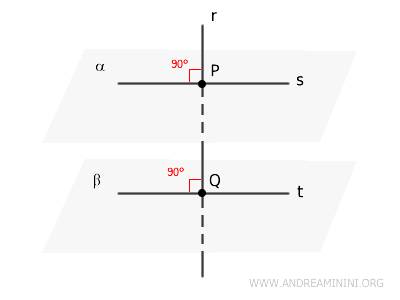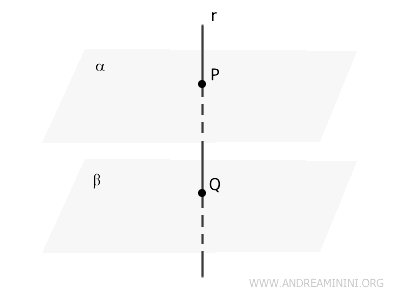Perpendicular Line Theorem for Two Planes
If a line \( r \) is perpendicular to two planes \( \alpha \) and \( \beta \) at points \( P \) and \( Q \), respectively (where \( P \) and \( Q \) are distinct points on the line), then the two planes \( \alpha \) and \( \beta \) are parallel, i.e., \( \alpha \parallel \beta \).

This theorem in solid geometry is a powerful tool for analyzing the relationships between lines and planes in three-dimensional space.
The Proof
Let \( r \) be a line that intersects the planes \( \alpha \) and \( \beta \) at points \( P \) and \( Q \), respectively.
By assumption, \( r \) is perpendicular to both \( \alpha \) and \( \beta \).

This means \( r \) forms a right angle with every line lying in \( \alpha \) that passes through \( P \), as well as with every line lying in \( \beta \) that passes through \( Q \).
Next, consider a line \( s \) in \( \alpha \) passing through \( P \), and a line \( t \) in \( \beta \) passing through \( Q \).

Since \( r \) is perpendicular to \( \alpha \), it must also be perpendicular to \( s \).
Similarly, \( r \) is perpendicular to \( t \).
Now, let’s assume for the sake of contradiction that \( \alpha \) and \( \beta \) are not parallel.
If \( \alpha \) and \( \beta \) were not parallel, they would intersect along a line \( u \). This would mean \( u \) belongs to both \( \alpha \) and \( \beta \).
Since \( r \) is perpendicular to all lines in \( \alpha \) passing through \( P \), it would also be perpendicular to \( u \) because \( u \) lies in \( \alpha \).
$$ u \subset \alpha $$
Likewise, because \( r \) is perpendicular to all lines in \( \beta \) passing through \( Q \), it would also be perpendicular to \( u \) since \( u \) lies in \( \beta \).
$$ u \subset \beta $$
However, it is impossible for a single line \( r \) to be perpendicular to the same line \( u \) at two distinct points \( P \) and \( Q \), as this would contradict the uniqueness of a perpendicular line at a given point.
Thus, the assumption that \( \alpha \) and \( \beta \) are not parallel is false.
Consequently, the two planes must be parallel.
Alternative Proof
Consider a line \( r \) that is perpendicular to the plane \( \alpha \) at point \( P \).
Since \( r \) is perpendicular to \( \alpha \) at \( P \), the direction vector of \( r \), denoted as \( \vec{v} \), is a normal vector (orthogonal) to the plane \( \alpha \).
This means \( \vec{v} \) is perpendicular to every vector in \( \alpha \).
Similarly, \( r \) is perpendicular to \( \beta \) at point \( Q \), so \( \vec{v} \) is also a normal vector to the plane \( \beta \).
Since \( \vec{v} \) serves as the normal vector for both \( \alpha \) and \( \beta \), the two planes share the same normal direction, which implies their normal vectors are parallel.
When two planes have parallel normal vectors, the planes themselves must be parallel. Therefore, \( \alpha \) and \( \beta \) are parallel.
And so the theorem is proved.
